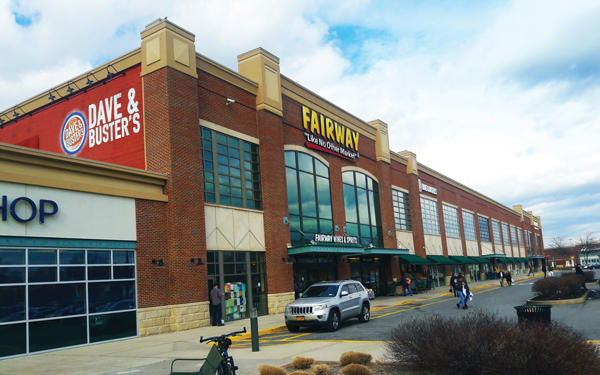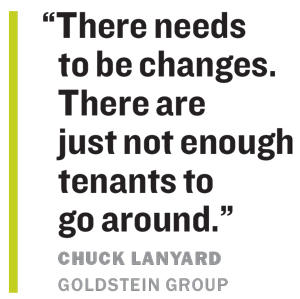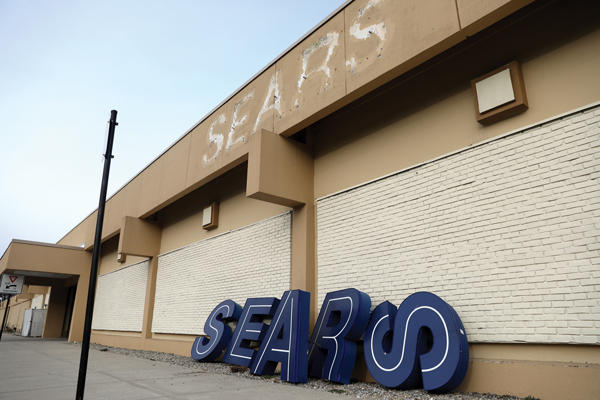Across the country, competition from internet retailers has left the leasing landscape strewn with dark-windowed hulks. Victims include one-time anchor tenants like Toys “R” Us, Sears and J.C. Penney. Some of their old homes, decimated by the “retail apocalypse,” await a new purpose, while others have been razed.
That has left retail brokers and landlords in the tri-state region searching for solutions in former big box spaces, be it through demolition, subdivision or acquisition.
Brian Katz, CEO of Englewood Cliffs, New Jersey-based retail brokerage Katz & Associates, said the current retail market is the most sluggish he’s seen in his 23 years as an agent.
“It’s not being driven by lack of demand, but caution,” Katz said. “Is there another big bankruptcy that’s about to come? Landlords are taking time to make the right decision.”
In the densely populated and relatively affluent area around New York City, some landlords are having better luck filling vacancies by sorting though a list of suitors seeking to move into retail properties.
Discount retailers once considered places like Nassau County too pricey, said several tenants, landlords and brokers contacted for this story. But now those businesses that cater to bargain hunters can purchase the remainder of leases inked years ago when retail rents were cheaper, at discounts of up to 75 percent. National chains like Big Lots, Raymour & Flanigan and T.J. Maxx have gained new footholds.

And it isn’t just cheaper rents fueling a potential revival. Landlords have embraced the expensive proposition of redesigning cavernous department store spaces into smaller slices. Eager to make deals, property owners have pushed back on co-tenancy restrictions to invite nontraditional tenants — such as gyms, grocery stores and movie theaters — into those seemingly outdated big boxes.
“The end of brick-and-mortar has been overdone here, definitely,” said Matthew Harding, CEO of Plainfield, New Jersey-based shopping center owner Levin Management. “It won’t all be bricks-and-mortar, but it won’t all be online.”
And retail’s future can sometimes be found in the past. Sears filed for bankruptcy in October, but its real estate remained a hot commodity, so much so that the company’s former CEO and current chairman, Edward Lampert, successfully bid $5.2 billion in February to acquire the department store chain’s assets and prevent its liquidation.
Toys’ takers
Of the dozen or so major retail chains that have announced mass store closings in recent years, Toys “R” Us and its affiliate Babies “R” Us, which collectively filed for bankruptcy in 2017, could have the most valuable real estate, brokers said.
Toys “R” Us has tapped outside firms to liquidate all 735 of its locations — about a third of which the company owned — despite an as-yet-unapproved plan by some lenders to try and resurrect the retail brand. New York-based Raider Hill Advisors is seeking to sell or lease 318 Toys “R” Us properties, 10 of which are in the tri-state area, including the company’s former 585,000-square-foot headquarters in Wayne, New Jersey. The company declined to comment on its plans.
Often situated on highly trafficked roads and generally apart from other retail destinations — obviating the risk that a new tenant could get stuck in a dying mall — discount stores have expressed interest in such sites. In the Toys “R” Us bankruptcy, eight properties have received offers, and while a judge determined that six bids were too low, some are moving forward.
In late 2018, the remaining 12-year lease on a 36,000-square-foot Toys “R” Us store in Paramus, New Jersey, sold to Big Lots for $2.75 million, or about $6.50 a square foot annually.

A former Kmart store at Post Road Plaza in Pelham, New York, has been carved up into a Fairway Market, Dave & Buster’s and 24 Hour Fitness.
Had Big Lots signed a new lease for a comparably roomy locale, the Ohio-based discount retailer could have paid $30 per square foot, the going rate in a desirable submarket, local brokers said. After that steal of a deal, Big Lots cut a ribbon in January for a former Toys “R” Us store in Bay Shore, New York, its ninth location on Long Island.
Do-not-rent lists
Raymour & Flanigan, the largest furniture retailer in the Northeast, has emerged as another suitor for old Toys “R” Us stores. The Syracuse-based retailer has sought to penetrate the pricey tri-state region, but it ran into opposition when it paid $1.3 million for the remaining nine years on a lease for another former Toys “R” Us in Paramus, this one with 45,000 square feet.
The property, built in 1970 and one of Toys “R” Us’ first locations, was picked up by Raymour & Flanigan through an auction last year in a deal that gave it a rent of about $10 per square foot, below the regional average. N.T. Hegeman Company, the site’s Paramus-based owner, sued to block the transaction, citing a provision in its lease, known as a covenant, barring retailers from selling furniture and automobiles.
Hegeman general partner M. John Germain said the covenant was intended to protect furniture-selling tenants at nearby properties controlled by the family-owned commercial real estate company. “We use them to protect other tenants,” he said. A judge, however, ultimately sided with Raymour & Flanigan, which declined to discuss the matter.
The case could send ripples across the tri-state retail landscape. Had Hegeman prevailed in the litigation with Raymour & Flanigan, Germain admitted, he would’ve razed the former Toys “R” Us store and built anew. Germain said the traditional big box store is “dying out,” citing 2,500 square feet as a popular store size today, a far cry from the behemoths that once ruled suburbia.
Bans on certain businesses, imposed to benefit tenants, have hobbled deals, said several brokers and landlords. Department stores have insisted that malls exclude medical facilities, grocery stores and gyms, whose customers often stay on-site for several hours and take up valuable parking spaces.
 But as gym visits become shorter — and landlords grow more desperate — some property owners are disallowing tenants from adding those lease provisions, said Chuck Lanyard, president of Paramus-based retail brokerage the Goldstein Group. “There needs to be changes,” he said. “There are just not enough tenants to go around.”
But as gym visits become shorter — and landlords grow more desperate — some property owners are disallowing tenants from adding those lease provisions, said Chuck Lanyard, president of Paramus-based retail brokerage the Goldstein Group. “There needs to be changes,” he said. “There are just not enough tenants to go around.”
Meal tickets
While grocery stores have been a retail growth sector over the past decade, oversaturation has pumped the brakes on that expansion.
There were 29 percent fewer grocery store openings in 2017 than the year prior, according to a JLL market report. That decline came even as grocery store-anchored shopping centers saw a 5.3 percent spike in investments, per JLL, which noted it was one of the few retail sectors to experience growth.
Lanyard said that the tri-state area, a region riddled with now-defunct A&P and Pathmark food stores, has remained resilient. He cited the expansion of specialty grocers like H Mart, an upscale Korean chain building out its base in northern New Jersey, as one reason why grocery market activity remains strong. In early 2018, an H Mart took over a 25,000-square-foot berth at the Paramus Junction strip mall that until 2016 had been home to a Staples. (Paramus Junction’s owners, Advance Group and Invesco Real Estate, said in January that they would sell the 75,000-square-foot property for an undisclosed sum.)
Paramus Park, a nearby enclosed mall owned by General Growth Properties, was rocked this winter by the closing of a Sears that had served shoppers since 1974. Riding to the rescue was Stew Leonard’s, a Norwalk, Connecticut-based grocery chain known for its petting zoos and low prices. The grocer swallowed up 20,000 square feet for office space and announced plans for a new 80,000-square-foot market next door.
Dividing, to conquer
Subdividing darkened department stores into new developments is a smart leasing strategy, but the upside is not always realized overnight, said Levin’s Harding. When a Kmart closed in 2008 at his Post Road Plaza in Pelham, in Westchester County, Levin began a $15 million renovation to break up the 200,000-square-foot, two-level store into smaller spaces, adding extra windows and a red brick façade.
Upscale grocer Fairway Market took over 75,000 square feet of the former Kmart store in 2009, while arcade and restaurant chain Dave & Buster’s moved into the space in 2015, following by a 24 Hour Fitness last year. Dave & Buster’s has moved into a few former tri-state department stores, having taken over part of an old Sears at the Willowbrook Mall in Wayne last year, as well as a former Walmart at Long Island’s Westfield Sunrise Mall in Massapequa.
 Alternative tenants like arcades, grocery stores and gyms “are exactly the kinds of tenants you want today,” said Harding, noting that Post Road Plaza is now 97 percent occupied. Asking rents at the property are now $40 to $50 per square foot. But to recruit such tenants, landlords still must take into account certain sensitivities.
Alternative tenants like arcades, grocery stores and gyms “are exactly the kinds of tenants you want today,” said Harding, noting that Post Road Plaza is now 97 percent occupied. Asking rents at the property are now $40 to $50 per square foot. But to recruit such tenants, landlords still must take into account certain sensitivities.
Harding said he anticipated Fairway would not want a gym to be next door, so on spec he created a new entrance behind the former Kmart, with parking to match.
Taking stock of Sears
Kmart and its parent, Sears, lost $12 billion since 2010. But unlike Toys “R” Us, Sears avoided dissolution. Lampert’s takeover bid — the only one that sought to keep the company alive — saved 425 stores, some of which will be sold or subleased as Sears exits bankruptcy.
Sears and its executives, it seems, know the value of its properties. Lampert’s offer for Sears was the latest in a series of deals between him and the company. In 2015, Sears spun off the real estate investment trust Seritage Growth Properties to sell or redevelop 266 stores, only 101 of which included an actual Sears store as a tenant as of early 2019. Seritage, also chaired by Lampert, a hedge fund executive, now has 232 properties in its portfolio.
Seritage is currently adding a 987-seat movie theater and a 24 Hour Fitness to a former two-story Sears that was once a mainstay of Suffolk County’s Huntington Square Mall in East Northport. Another 24 Hour Fitness is slated for an empty Sears in Yorktown Heights, in Westchester, while Seritage is behind the proposed Heritage Village, a mixed-use complex on a former Sears site in Hicksville that includes plans for a 348-seat movie theater from iPic Entertainment.
When large retail chains do announce mass stores closures, Westchester, southern Connecticut, northern New Jersey and Long Island are often spared. The recent spate of shuttered Sears stores only included two within 100 miles of Manhattan, and of the more than 100 J.C. Penney stores that have gone dark since 2017, only a handful are in the tri-state area.
That has some predicting that retail’s rebirth — not its demise — is alive and well in the suburbs around Manhattan.
“In this region, there’s so little opportunity,” said Joseph French Jr., a senior vice president at the investment sales firm Marcus & Millichap. “Retail is valuable because it’s so hard to build [here]. These boxes all get rented again.”
E-commerce makes up only 15 percent of total retail sales nationwide, French said. “This story isn’t over yet,” he added.
